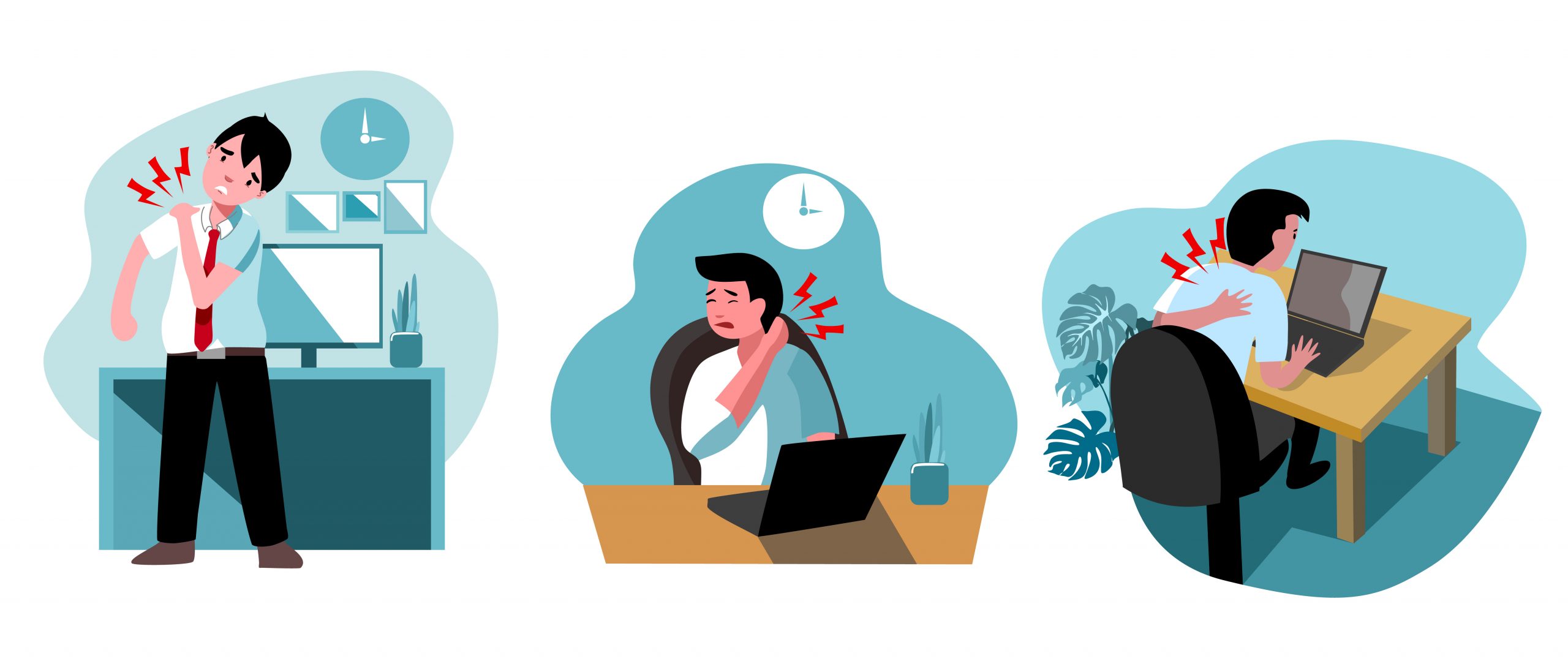Surbhi (name changed), 34, felt dizzy whenever she looked at the screen. She first thought it must be something she ate or some vision problems that was causing the discomfort. However, she later realised the pain was emanating from her neck. She sought the help of a physiotherapist who examined her and found the neck muscles were very tight and because of constant slouching at the computer, there was a hump at the base of her neck.
Surbhi required a week of physiotherapy that included ultrasound therapy, electrotherapy, massage, and exercises. She understood that most of her problems started because of postural issues. Her physiotherapist advised her to adjust the desk, so she doesn’t need to bend forward and to continue exercises to strengthen her neck and back muscles.
Neck pain is not so uncommon among those working on their desks all day. In a 2016 study conducted among administrative workers between 31 to 50 years in a tertiary care hospital in Delhi, more than 43% suffered from neck pain. In 28% of them, the neck pain was related to their workplace, also known as work-related neck pain. Recently, this kind of neck pain due to excessive usage of phones, tablets, and computers has been termed as ‘tech neck’.
Globally, the prevalence of one year of neck pain is between 15-34%, and musculoskeletal disorders (MSD) are the most common causes of long-term sick leave and disability pension.
Here are some of the common reasons for neck pain and what can be done to prevent and manage the pain.
Why does your neck hurt?
In the study mentioned above, factors like awkward posture, repetitive work, and aggravation of previous episodes are some of the reasons for neck pain.
Most neck problems arise because of bending forward while working on the computer. By bending forward, the weight of the front body drops down, pulling your head with it. This causes the shortening of neck muscles and increases their strain. Long hours of sitting further weaken the muscles in the chest, back, and legs, creating an imbalance.
Some symptoms of neck issues include a stiff neck, sharp pain, tingling sensation in the shoulders and hands, pain in the neck while moving, and headache.
Experts recommend acting when there is pain to prevent long-term changes in the spine. Exercises and rest can resolve the pain early, but patients require physiotherapy treatment and medication at later stages.
Let’s dig deeper into the issue!
Spondylitis vs spondylosis
Wait, wondering if the pain in the neck is spondylitis or spondylosis? You are not alone. The terms have been used interchangeably but refer to two very distinct conditions.
Spondylitis or Ankylosing spondylitis (AS) is an inflammatory disease that, over time, can cause some of the bones in the spine (vertebrae) to fuse. This fusing makes the spine less flexible and can result in a hunched posture, according to MayoClinic. It causes inflammation in other parts of the body, especially the eyes. There is no cure for the condition, and treatment can only slow the progression or reduce pain. Those with a certain gene (HLA B-27) are likelier to suffer the condition.
Spondylosis meanwhile is a general term for age-related wear and tear affecting the cushion between the spinal disks. With the cushion becoming fibrous, there is a reduction in the space between the spinal disks causing pain and rigidity in the spine. Usually, spondylosis occurs in those above the age of 40s but can occur early due to repetitive stress and prolonged sitting in poor postures.
What we may be referring to as spondylitis may be spondylosis as it is caused by wear and tear and repetitive stress.
Exercises for neck pain:
Hyoid smile: Tuck your chin slightly, feel the back of your neck lift up and then press the palm of your hand on your forehead. Resist the palm by pushing against it. Do this thrice.
Heart opener: While sitting on the chair with feet on the ground, fold your hands behind your back and lift your head towards the ceiling. Now, slowly nod up and down and side to side. Do this couple of times. This movement counteracts slouching.
Shrug the shoulders: Sitting erect on the chair, breathe in and pull your shoulders towards your ears. Breathe out, roll back the shoulders and lift the chest. Repeat ten times. This movement improves postures and prevents neck and shoulder pain.
Tips to prevent neck pain:
Be vigilant of your desk posture:
One of the side-effects of working from home after the pandemic is that many of us are resting our laptops on the dining tables, the sofas, or worse, the bed. This means we are working for long hours in a not-so-ideal setup that puts strain on our necks and back.
• The first step in correcting it is to find a fixed workstation and adjust it to support your back.
• Ensure that your laptop screen is at your eye level and you don’t have to slouch to look at the screen, do this by placing a box or couple of thick books underneath your laptop.
• Work on a chair with adjustable armrests so that your hands are supported when typing or using the mouse. Using an external mouse and keyboards may help.
• Also ensure your legs are at a right angle and feet are on the ground. This is the posture that puts the least amount of stress on your body during work.
The same corrective measures apply even if you are working at the office, like ensuring the screen is at eye level, legs are at the right angle, feet placed on the ground, and hands on the armrest, close to the body.
Take frequent breaks:
Even if you have an ergonomic set-up, the muscles in our back and the legs weaken if we stay in one position for a longer duration. This is why you need to take two-minute breaks after every hour to move around and stretch your body. Use this break to take your eyes off the screen: drink water, stare outside the window or take a short walk around the premises.
Support your back:
In case you do not have a chair with lower back support, place a pillow or rolled-up towel at the base of the back support, this will give you adequate provision for your lower back.
Fix workout routine:
Regular workouts especially strength training can prevent neck pain. This is because your shoulder, neck, and back muscles become strong enough to take the strain. In case you are already experiencing neck pain, seek consultation with a physiotherapist before you start working out.
The Treatment for Neck Pain
If the pain in the neck is so much that it affects daily activities, seek a doctor’s help. Based on your symptoms the doctor can diagnose your condition or you may be asked to do additional tests like an X-ray, CT scan, or MRI. They can suggest over-the-counter medication like NSAIDs to ease the pain. Treatment may include corticosteroid injection, massage therapy, physical therapy, and exercises.
For further information and consultation please get in touch with Dr.Prakhar Mishra , Consulting Orthopaedic Surgeon, at HCL Healthcare, having more than 7year clinical experience in treating neck/shoulder/back/knee related pain.
You can book your appointment by calling on our toll-free number
7217890075 or by filling the service request form here







